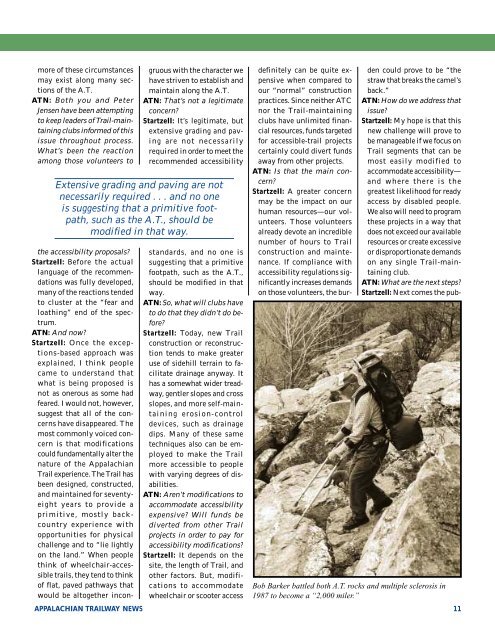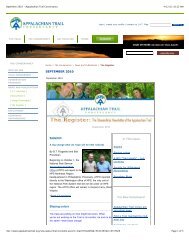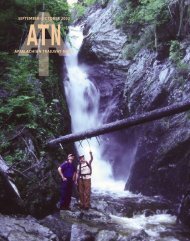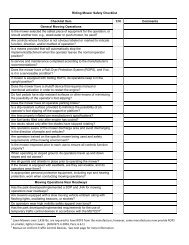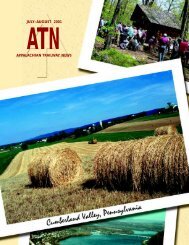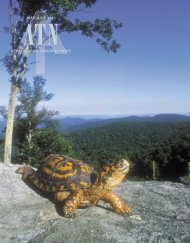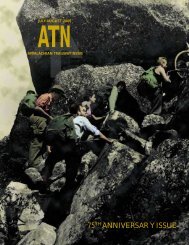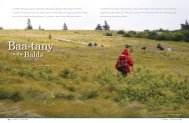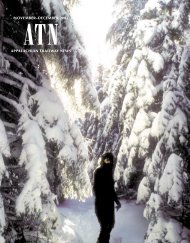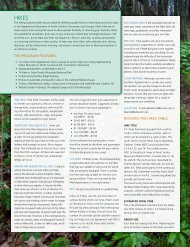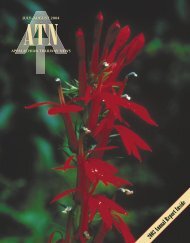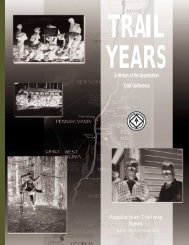atn mayâjune 2000 appalachian trailway news
atn mayâjune 2000 appalachian trailway news
atn mayâjune 2000 appalachian trailway news
You also want an ePaper? Increase the reach of your titles
YUMPU automatically turns print PDFs into web optimized ePapers that Google loves.
more of these circumstances<br />
may exist along many sections<br />
of the A.T.<br />
ATN: Both you and Peter<br />
Jensen have been attempting<br />
to keep leaders of Trail-maintaining<br />
clubs informed of this<br />
issue throughout process.<br />
What’s been the reaction<br />
among those volunteers to<br />
the accessibility proposals?<br />
Startzell: Before the actual<br />
language of the recommendations<br />
was fully developed,<br />
many of the reactions tended<br />
to cluster at the “fear and<br />
loathing” end of the spectrum.<br />
ATN: And now?<br />
Startzell: Once the exceptions-based<br />
approach was<br />
explained, I think people<br />
came to understand that<br />
what is being proposed is<br />
not as onerous as some had<br />
feared. I would not, however,<br />
suggest that all of the concerns<br />
have disappeared. The<br />
most commonly voiced concern<br />
is that modifications<br />
could fundamentally alter the<br />
nature of the Appalachian<br />
Trail experience. The Trail has<br />
been designed, constructed,<br />
and maintained for seventyeight<br />
years to provide a<br />
primitive, mostly backcountry<br />
experience with<br />
opportunities for physical<br />
challenge and to “lie lightly<br />
on the land.” When people<br />
think of wheelchair-accessible<br />
trails, they tend to think<br />
of flat, paved pathways that<br />
would be altogether incongruous<br />
with the character we<br />
have striven to establish and<br />
maintain along the A.T.<br />
ATN: That’s not a legitimate<br />
concern?<br />
Startzell: It’s legitimate, but<br />
extensive grading and paving<br />
are not necessarily<br />
required in order to meet the<br />
recommended accessibility<br />
Extensive grading and paving are not<br />
necessarily required . . . and no one<br />
is suggesting that a primitive footpath,<br />
such as the A.T., should be<br />
modified in that way.<br />
standards, and no one is<br />
suggesting that a primitive<br />
footpath, such as the A.T.,<br />
should be modified in that<br />
way.<br />
ATN: So, what will clubs have<br />
to do that they didn’t do before?<br />
Startzell: Today, new Trail<br />
construction or reconstruction<br />
tends to make greater<br />
use of sidehill terrain to facilitate<br />
drainage anyway. It<br />
has a somewhat wider treadway,<br />
gentler slopes and cross<br />
slopes, and more self-maintaining<br />
erosion-control<br />
devices, such as drainage<br />
dips. Many of these same<br />
techniques also can be employed<br />
to make the Trail<br />
more accessible to people<br />
with varying degrees of disabilities.<br />
ATN: Aren’t modifications to<br />
accommodate accessibility<br />
expensive? Will funds be<br />
diverted from other Trail<br />
projects in order to pay for<br />
accessibility modifications?<br />
Startzell: It depends on the<br />
site, the length of Trail, and<br />
other factors. But, modifications<br />
to accommodate<br />
wheelchair or scooter access<br />
definitely can be quite expensive<br />
when compared to<br />
our “normal” construction<br />
practices. Since neither ATC<br />
nor the Trail-maintaining<br />
clubs have unlimited financial<br />
resources, funds targeted<br />
for accessible-trail projects<br />
certainly could divert funds<br />
away from other projects.<br />
ATN: Is that the main concern?<br />
Startzell: A greater concern<br />
may be the impact on our<br />
human resources—our volunteers.<br />
Those volunteers<br />
already devote an incredible<br />
number of hours to Trail<br />
construction and maintenance.<br />
If compliance with<br />
accessibility regulations significantly<br />
increases demands<br />
on those volunteers, the burden<br />
could prove to be “the<br />
straw that breaks the camel’s<br />
back.”<br />
ATN: How do we address that<br />
issue?<br />
Startzell: My hope is that this<br />
new challenge will prove to<br />
be manageable if we focus on<br />
Trail segments that can be<br />
most easily modified to<br />
accommodate accessibility—<br />
and where there is the<br />
greatest likelihood for ready<br />
access by disabled people.<br />
We also will need to program<br />
these projects in a way that<br />
does not exceed our available<br />
resources or create excessive<br />
or disproportionate demands<br />
on any single Trail-maintaining<br />
club.<br />
ATN: What are the next steps?<br />
Startzell: Next comes the pub-<br />
Bob Barker battled both A.T. rocks and multiple sclerosis in<br />
1987 to become a “2,000 miler.”<br />
APPALACHIAN TRAILWAY NEWS 11


